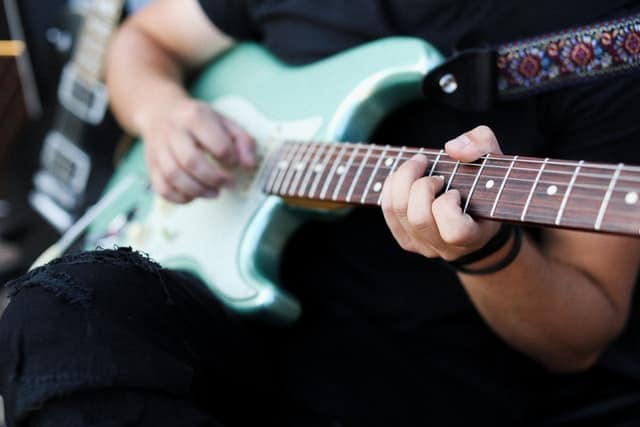Maintenance is an important aspect of owning an instrument. When it comes to guitars, there’s a lot to consider, from the body to the wood, to the electronics, but today we’re going to focus on the fretboard. Is it necessary to oil your guitar fretboard?
In short, oiling your guitar fretboard is a necessary maintenance requirement, but it’s not something you need to be doing every time you change your guitar strings. There are some exceptions when it comes to certain fretboards though.
We’ll cover exactly why fretboards need oil, which fretboards don’t need to be oiled, and how to check which one you have. Finally, we’ll also be going over how often you should oil your fretboard and how to properly oil do so.
Why do fretboards need oil?
Your fretboard needs oil because, over time, they become dehydrated due to moisture loss and other factors. Fretboard oil is made to keep your wood hydrated and counteract the moisture loss
When you play your guitar, your fingers leave behind sweat on the fretboard and the salts from your sweat get drawn into the wood. This is one contributing factor that causes your fretboard to dry out.
Other causes are weather changes and just the amount of time you’ve had your guitar in general. Exposure to sunlight, harsh winds, dust, and many other small things all contribute to your guitar losing moisture over time.
But why do we need to keep the fretboard moist?
Is it really necessary to oil your guitar’s fretboard?
If the wood on your fretboard dries out too much, it will crack, wear out, and in extreme cases, your frets might not sit as well in the neck anymore. So keep your fretboard oiled.
There are bits of advice floating on the internet suggesting using olive oil or just plain water, and following this advice will actually damage your guitar more.
Olive oil is a food oil and it will rot over time, which I’m sure nobody wants to think about. Water just simply isn’t as good as natural wood oils and it could even cause rust on your frets.
You should use natural oils that have been made specifically for guitar fretboards like Fender Custom Shop Fingerboard Remedy or Dunlop’s Lemon Oil. These are made to replace the moisture that your fretboard naturally loses over time.
The only time when it’s not necessary to oil your fretboard is when it’s been varnished. Wood Varnish creates a natural seal that prevents the wood from losing moisture over time, you should still clean your fretboard though.
If you’re unsure about whether your fretboard is varnished or not, just hold it up to the light and check if it has a shine to it. Does it have a glint to it? Then it’s varnished.
How often should you oil your fretboard?
Probably less than you’d think. You don’t need to oil your fretboard very often. It’s recommended that you do it once every six months at most, but even once a year will do fine.
If you over-oil your guitar neck, it can lead to just as much damage as never oiling your guitar neck. It’s all about balance and too much oil will oversaturate the wood and lead to warping.
Is it bad if you have never oiled your guitar’s fretboard?
Well, it depends on how long you’ve had your guitar. Guitar fretboards can go a very long time without being oiled and not crack or become damaged, but you should oil your guitar fretboard at least once a year.
There are camps of opinion that believe that you should never oil the guitar neck and maybe they believe it’s just a scam, but going to the opposite extreme is still not good.
If you’ve had your guitar for years and you’ve never oiled it and it’s still alright, that’s great, but I would recommend still going out and getting some oil for your fretboard. You’d be amazed at how it will make your neck look brand new.
The only guitar fretboard that you need not oil is a varnished or sealed one because its moisture remains locked in under the varnish. You’d also be wasting oil and your money.
How to oil your guitar’s fretboard
If you’re like me, you’re probably reading this section with your guitar sitting in front of you, looking for the steps. But before you oil your guitar fretboard, there’s a bit of prep work involved as well as good practice, so we’re going to go over that first.
For starters, the type of oils you can and can’t use:
- Dunlop 65 Lemon Oil
- Normal Lemon Oil(Cheaper than Dunlop, but works just as well if you’re on a budget)
- Behlen Fingerboard Oil
- Crimson guitars’ fretboard restorative Oil
- Mineral Oil
Don’t use:
- Olive oil or any other vegetable oil
- Vinegar
- WD-40
- Rubbing Alcohol
- Grease
- Linseed Oil
- Tung Oil
Types of clothes you can use:
- Microfibre cloths to clean your guitar
- Ultra-fine 0000 steel wool to clean the grim(will go over the exact how later)
Setup
You’ll need a well-lit space for your guitar and something you can lay it down on like a countertop or a work table. Make sure the surface is clean before you lay your guitar down so that you don’t risk scratching the finish of your guitar on bits of dust.
Next, you’ll obviously need to remove the strings to reach the fretboard, but, you will also want to make sure that no oil can get onto the body of your guitar. For this, it helps to have a large cloth to lay over the body while you’re working, make sure this is clean too.
You can use low-tack tape to hold down the edges of the cloth and really get a tight wrap around the fretboard so that the oil doesn’t get in under the edges of the cloth you’re laying over the body.
Clean the fretboard
Before you go applying oil, you’ll want to clean the fretboard of any grime and dirt first. You wouldn’t want that getting pushed into the wood. What’s nice is that just rubbing the fretboard with oil will get a lot of grime off, but there’s a better way.
Did you know you can use a toothbrush to get at the grime? It’s something I and even master Luthiers recommend because the bristles can easily get into the tight edges where the frets meet the board while also not being so hard that they’ll scratch the fretboard.
You can also use a Q-tip to lift dust.
An important thing to note is that you should never spray any liquids or oils directly onto the neck, always apply it to a cloth and use that to wipe it on.
If you have a Maple Fretboard, you can rest a little easier and just use a damp cloth to get at the grime.
Applying the oil
Finally, we’re at the part you wanted to know about most.
First off, Apply your chosen oil to a microfibre cloth or ultra-fine steel wool cloth, and then simply start rubbing the oil in. If you’re using a cloth, you can work it in all directions and get in nice and close to the frets.
I use both the cloth and the ultra-fine steel wool. When using steel wool, it’s best to work along the grain so you don’t cause any tiny scratches to your fretboard.
Pro tip: Let the oil sit on the fretboard for about five minutes before wiping the excess oil off, this allows it time to really draw into the wood.
Afterward, you should use a dry cloth to wipe off the excess oils, and then you’re pretty much done.
After Oiling and general tips
After you’re done oiling your guitar fretboard, you can also use a fretboard conditioner to add the cherry on top, but it’s not a necessity if you’re wondering.
That aside, what are some things you can do to keep your fretboard still looking shiny and clean for as long as possible?
Well, for one, you can practice good guitar maintenance, like keeping your guitar in its case when not in use and not leaving it standing in dusty areas.
Something that might surprise you to think about is the cleanliness of your hands. If you really want to maintain your guitar’s clean look, you should wash your hands before you play.
It sounds pretty cumbersome, but aside from just the natural oils that build up on your skin, your hands come into contact with a ton of filth throughout the day, and then you’re putting all that onto your guitar…

Hello there, my name is Ramiro and I’ve been playing guitar for almost 20 years. I’m obsessed with everything gear-related and I thought it might be worth sharing it. From guitars, pedals, amps, and synths to studio gear and production tips, I hope you find what I post here useful, and I’ll try my best to keep it entertaining also.





